
The Gotha G.V was a heavy bomber used by the Luftstreitkräfte during World War I. Designed for long-range service and built by Gothaer Waggonfabrik AG, the Gotha G.V was used principally as a night bomber.

The Gotha G.I was a bomber aircraft used by the Luftstreitkräfte during the First World War.

The AGO C.I was a First World War German pusher reconnaissance biplane that used a pod-and-boom configuration.
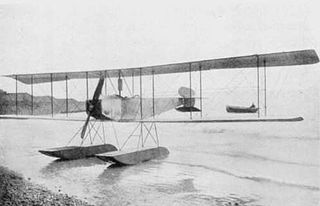
The Avro Type H, Type 501, and Type 503 were a family of early British military seaplanes. They were a development of the Avro 500 design and were originally conceived of as amphibious, the prototype being fitted with a single large main float under the fuselage, and two outrigger floats under the wings.

The Friedrichshafen G.I was a prototype heavy bomber aircraft that was built in Germany by Flugzeugbau Friedrichshafen in 1915. It was Karl Gehlen's first design for the company, and although it was not produced in quantity, it provided the foundation for the later, highly successful bombers culminating in the G.III.

The Friedrichshafen G.II was a heavy bomber aircraft that was designed and manufactured in Germany during World War I by Flugzeugbau Friedrichshafen. The plane was used by the Luftstreitkräfte for tactical and limited strategic bombing operations.
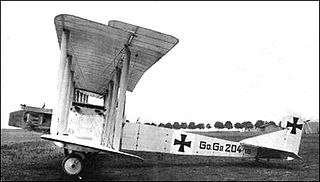
The Gotha G.II series was a heavy bomber used by the Luftstreitkräfte during World War I.

The Friedrichshafen FF.31 was a two-seat prototype German maritime reconnaissance floatplane built by Flugzeugbau Friedrichshafen during the First World War. Although primarily intended for reconnaissance duties, the aircraft was provided with a machine gun to engage other aircraft. Although it was satisfactory for its intended mission, it lacked the performance necessary for use as a fighter. A pair of aircraft were built in 1915 and it was not accepted for production by the Imperial German Navy's Naval Air Service.
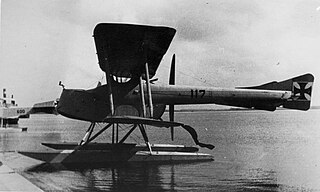
The Friedrichshafen FF.34 was a German biplane floatplane of the 1910s produced by Flugzeugbau Friedrichshafen.
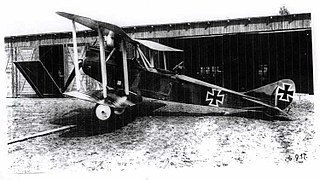
The Rumpler C.IV was a German single-engine, two-seat reconnaissance biplane. It was a development of C.III with different tail surfaces and using a Mercedes D.IVa engine in place of the C.III's Benz Bz.IV. The Rumpler 6B 2 was a single-seat floatplane fighter variant with a 120 kW (160 hp) Mercedes D.III engine built for the Kaiserliche Marine.

The Hansa-Brandenburg W.19 was a German fighter-reconnaissance aircraft of World War I. It was a single-engined two-seat biplane floatplane, and was a larger development of the successful W.12. It served with the Kaiserliche Marine during 1918.

The Friedrichshafen FF.35 was a German three-seat floatplane torpedo bomber built during World War I by Friedrichshafen Flugzeugbau built for the Imperial German Navy's Naval Air Service. Only one prototype was constructed in 1916 and it saw limited operational use during the war in Courland.

The Gotha G.VII was a bomber aircraft produced in Germany during the final months of World War I. With the strategic bombing campaign effectively over, it was intended to be a high-speed tactical bomber with a secondary reconnaissance capability.
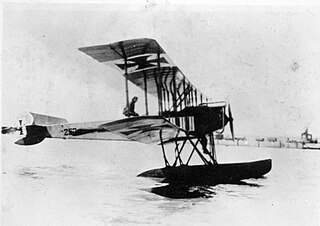
The Gotha WD.2 and its derivatives were a family of military reconnaissance aircraft produced in Germany just before and during the early part of World War I.

The Gotha WD.7 was a twin-engine maritime patrol and torpedo-bomber training floatplane developed during World War I by Gothaer Waggonfabrik for the Imperial German Navy's Naval Air Service. The WD.8 was a single-engine version of the WD.7 developed for comparative purposes. The single aircraft built was deemed "totally unsuitable" by the Naval Air Service and was later sold to the Ottoman Empire.

The Gotha WD.11 was a three-seat floatplane torpedo-bomber developed during World War I by Gothaer Waggonfabrik for the Imperial German Navy's Naval Air Service. The company's earlier Gotha WD.7 had been moderately successful as a training aircraft for torpedo tactics and it designed a larger and more powerful aircraft along the same general lines. The prototype was completed in 1916 and the aircraft entered service the following year. 17 examples were built and enjoyed limited success, sinking two British freighters in the North Sea. One squadron participated in Operation Albion in 1917 with limited effectiveness. Torpedo shortages and durability issues forced the WD.11s removal from active service in 1918. Fewer than half survived to be inventoried by the Allies after the war.

The Gotha WD.14, WD.20, and WD.22 were a family of biplane torpedo bomber floatplanes developed in Germany during World War I.
The Gotha G.VI was an experimental bomber aircraft designed and built in Germany during World War I.

The Hansa-Brandenburg W.18 was a single-seat German fighter flying boat of World War I. It was used by both the Kaiserliche Marine and the Austro-Hungarian Navy.

The LTG FD 1 was a single-seat floatplane fighter built for the Imperial German Navy's Naval Air Service by Luft Torpedo Gesellschaft (LTG) during World War I. Only six prototypes were built in 1917–1918 and are not known to have served on active duty.




















